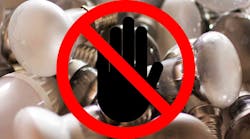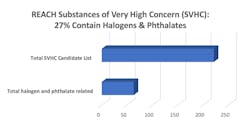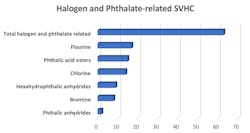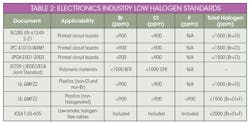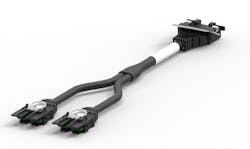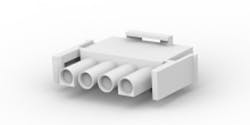This article is part of the RoHS and Critical Materials in our Series Library.
Download this article in PDF format.
Electronics companies have experienced some chemical reactions in the past two decades. Many will recall the European RoHS Directive (Restriction of Hazardous Substances), which came into force in 2006, that resulted in the need for lead-free components, solder, and manufacturing processes. Changes in electromechanical parts were affected, too, by restrictions on other heavy metals cadmium, mercury, and hexavalent chromium. The same Directive also restricted two classes of flame retardants, PBB and PBDE (polybrominated biphenyls and polybrominated diphenyl ethers). These last two are organic compounds based on carbon, containing one of the halogen group of elements, bromine.
Jumping Through Hoops
For several decades now, substances containing halogens have come under scrutiny for various environmental and health effects. There’s quite a history not only for the halogen-containing RoHS substances, but others containing either bromine, chlorine, or fluorine. In all fairness, many of these substances do their jobs quite well as insulators, flame retardants, refrigerants, cleaning agents, and so on.
Halogen concerns have risen outside the realm of electronics, notably the use of the chlorinated pesticide, DDT, highlighted in Rachel Carson’s book Silent Spring (1962). In 1999, there was an incident where polychlorinated biphenyls and the even more toxic chlorinated dioxins were found in livestock feed in Belgium.
Back to the world of electronics, the Montreal Protocol in 1987 prohibited the use of chlorofluorocarbons used as cleaning agents and refrigerants. Various studies have also shown that improper incineration of discarded end-of-life electronics products could release extremely toxic dioxins to the atmosphere. Finally, the class of polychlorinated biphenyls, which were used widely in large transformers and capacitors, have been classified as one of what have notoriously become known as the “dirty dozen” Persistent Organic Pollutants. You get the picture.
Increasingly, halogenated compounds are also under the watch of the EU’s REACH regulations (Registration, Evaluation, and Authorization of CHemicals). In fact, some 18% in the latest list of June, 2018 SVHC (Substances of Very High Concern) are halogen-containing. While presence of SVHC in products does not ban their use, it does bring obligations for reporting that nonetheless burdens the manufacturer.
Now add to this scenario another class of substances called phthalates. These compounds are based on phthalic acid, with side chains attached that perform the function of plasticizers and softening agents. Phthalates have been widely added to PVC (polyvinyl chloride), which is inherently rigid as found in PVC pipes, to make it flexible. PVC is a very common insulator that you most likely have around your home and office.
1. Halogen and phthalate SVHC.
Combined, these two categories—halogen and phthalate-related compounds—are nearly a third of the REACH SVHC list (Fig. 1). The combined halogen and phthalate-related SVHC are further broken down into more specific classifications in Fig. 2. Rather than deal with each substance and category piecemeal, any company currently needing to report SVHC in its products may want to consider a more comprehensive approach.
2. Halogen- and phthalate-related SVHC.
Today’s Customer and Reporting Requirements and Tomorrow’s Substance Bans
Another trend worth noting is for REACH SVHC to be included in updates of the more restrictive RoHS regulation. The four phthalates added to RoHS 2019 are detailed in Table 1, along with those that remain, for the time being, under the REACH regulation. REACH compliance obligations are currently limited to reporting, but as of July 2019, RoHS bans shipping articles with more than 0.1% of the listed phthalates into the EU if above 0.1% by weight.
While we will leave the science up to environmental chemists and toxicologists, and defer the regulations to the authorities, the bottom line is that companies may wish to take the initiative to move above the sea of regulations and develop halogen-free, phthalate-free products. In the remainder of this article, we provide some guidance on how to do just that. Fortunately, several standards organizations have published criteria that will help guide your work.
Standards to Guide You
While a company must be compliant to applicable legal requirements, an elective decision to conform to a voluntary industry standard may also make sense because doing so brings a broader based acceptance to a specific initiative. Table 2 lists some of the more prominent industry standards related to halogens. Iodine and astatine aren’t included in the standards, nor are they discussed in this article since they’re generally agreed to be of no relevance to electronics products.
You may first notice that the different standards cover rather specific usages, i.e. in printed circuit boards, or in polymers (plastics, elastomers etc.), or cables. There’s also some disagreement among the various limits in terms of ppm (parts per million), though this isn’t significant in most cases because, generally, the current usage levels are well into the percent range. Therefore, products meeting the standards would need a significantly different composition rather than just a partial reduction in the covered substances. The standards also differ in whether a specific limit of halogen Br (bromine), Cl (chlorine), or F (fluorine) or some combined sum of them conforms to the standard.
Various terminology has come to be used by electronics manufacturers in this regard, including: Halogen-Free, Non-Halogen, Non-Halogenated, Low Halogen, Zero Halogen, and Zerohal.
Yet another approach is to combine the definitions more broadly to include all applications, yet separate the types of halogen substances according to industry needs. The application-independent approach is listed in Table 3 (as used by TE Connectivity).
Customer Requirements
A low halogen product, by these criteria, meets or exceeds all of the industry standards of Table 2.
Other classifications that also exceed regulatory requirements may be of interest to specific customers.
For example, some OEMs specify JS709 in the engineering requirements for purchased parts. These applications may include cable-based products where a fluorine-containing cable has the desired properties for the application, and the fluorinated compounds aren’t a concern or aren’t listed as SVHC.
BFR/CFR/PVC-free products may also be specified. This category is an implied restriction of phthalates commonly used in PVC—unless the supplier offers a suitable substitute for conventional phthalates, an alternate base elastomer will probably have to be used to meet the customer requirement.
While some attempts have been made by industry to develop alternatives to phthalates, they aren’t as widely known nor are they considered as effective for their intended function. Moreover, even if phthalate replacement were to be accomplished successfully in PVC, the halogen content would still not be significantly changed due to the inherently high chlorine content of PVC (some 57% by weight). Because of these factors, current trends point to eliminating PVC as a basic material for insulations and jackets when required by the customer.
In the next sections, we discuss some of the available choices in selected commodity types—electronic components, plastics, and cables—and how they can be successfully implemented into products.
Circuit Boards and Components
Flame-retardant thermosets, including the epoxies and similar materials used for laminates, have traditionally contained halogen reacted into the polymer backbone. Device packages like discrete semiconductors, ICs, and molded passives like tantalum capacitors and encapsulated inductors have used similar materials. Only those components that are primarily made of metals and/or ceramics, such as resistors, multilayer capacitors, permanent magnets, and so on, are usually considered to be inherently halogen-free.
Traditional FR-4 epoxy circuit-board laminates have been made using a rather clever chemical reaction, where a brominated flame-retardant monomer, tetrabromobisphenol A (TBBPA), is reacted into the epoxy thermoset polymer backbone of the laminate. This loading of bromine provides significant flame-retardancy properties.
Considerable work has been done by suppliers and industry groups to develop, standardize, and make available halogen-free circuit board materials. One implementation is in the multilayer circuit board that’s used in the ChipConnect cable assembly shown in Fig. 3. This is an internal faceplate-to-processor cable assembly running at 25 Gb/s. Variations include 1 and 2 ports, with either linear or right-angle connectors available at the linear edge-connector end.
3. High-speed cable assembly uses (no BFR, CFR or PVC).
Circuit boards can be specified to conform to the JS709 standard, with less than 1000 pm each of brominated and chlorinated flame-retardants. Some examples of boards capable of conforming to this standard include EMC-888 (Elite Material Co. Ltd.), TU-863 Thunderclad (Taiwan Union Technology Corp.), and TerraGreen (Isola Group). These are being made in a variety of constructions and thicknesses.
Alternate solder-mask pigments are also available. Typically, these had been based on the compound, phthalocyanine green, chemical formula Cu(C32N8Cl14), which isn’t halogen-free. However, there’s a chlorine-free alternative that’s the same molecule without chlorine, shifting its color to blue, and known as phthalocyanine blue, Cu(C32H16N8). Additional examples include solder masks in a choice of halogen-free colors.
Following the switch to lead-free terminations, semiconductor suppliers have followed up with halogen-free mold compound for device packaging. A quick survey of the top semiconductor companies finds all to list halogen-free molded packages, as do many other semiconductor suppliers.
The availability of low halogen products from suppliers of molded passive components like tantalum capacitors has evolved similarly. Low halogen developments are ongoing, so the best source of information is web searches and direct contact with your preferred suppliers. While space prevents further discussion here, design teams should be aware of the options and inquire about availability. Keywords found in this article may be of benefit in your search.
Plastics and Flame Retardants
Plastics often need to have flammability protection for their intended applications and be rated by safety agencies. Suppliers have been developing alternatives to classical brominated and chlorinated flame retardants, beginning even before the original RoHS ban on PBB and PBDE. Other types of non-RoHS brominated flame-retardants may still be used (e.g. hexabromocyclododecane (HBCDD). However, its listing as a REACH SVHC is driving the move away from brominated compounds entirely. Some of the most promising replacement substitutes have been based on nitrogen and phosphorous.
TE MATE-N-LOCK is an example of a product line that’s low halogen. The 350766-1 plug housing, with a 3-position, 0.25-in. pitch for wire-to-board or wire-to-wire applications, is rated UL 94V-0 (Fig. 4).
4. TE 350766-1 low halogen plug housing.
Low-Smoke, Zero Halogen (LSZH) Cables
Without chlorine, polyvinyl chloride (PVC) would not exist. Achieving viable fluorine-free jacket materials has been challenging for cost-sensitive commercial products. Removing both fluorine and chlorine leaves compounders with few options, except to pursue polyolefin or elastomer-based ingredients, including LDPE, LLDPE, TPE, and TPU materials. In addition to verifying the low halogen content, candidate replacements must pass applicable low-smoke density tests, for example, UL Standard 1685 or IEC 61034. Refer to Low Smoke Zero Halogen High Speed Parallel Pair Cables for more information.
Rugged LSZH cables for the military and marine use are available. For example, Raychem MIL-DTL-24643 Zerohal PROFIBUS cables are 150-Ω twisted pairs available with one or two shields and one or two jackets that can also be water-blocked for marine and ship applications. Other applications include industrial automation.
Another series of low-halogen cables suitable for marine use are the Lightweight Low Fire Hazard Cables according to VG95218 part 28. These low halogen cables are available in a wide range of color-coded conductors and sizes. Lightweight and low fire hazard, these cables are available in a wide range of primary wires and screened cable components in pair, triple, and quad configurations. Additional product offerings, including VG-95218 Marine Cable, may be found in the catalog Wire and Cable: The Industry Standard for Rugged, Reliable Performance.
Last, but not least, a non-halogen insulator or heat-shrink tubing may also be needed for some cable assembly applications, including use in commercial and household appliances. Examples include tubing as listed in the brochure SWFR Single Wall, Heat Shrink Tubing Highly flame-retardant, UL VW-1 rated, Zerohal tubing. When a heavier heat-shrink solution is needed, see Raychem Heat-shrinkable Halogen-free, Heavy-wall Tubing ZCSM for Low Fire Hazard Areas. More low halogen types including both flame-retardant and non-flame-retardant grades, low recovery temperature, and fabric tubing are available for selection in Raychem Tubing Products: SINGLE WALL, DUAL WALL, HEAVY DUTY, SPECIAL PURPOSE AND MEDICAL-GRADE.
What Next?
We have traced the trend from environmental regulations and industry standards to customer requirements for products without halogens and phthalates. PCBs, molded components, plastic parts, cables, and shrink tubing across diverse electronics industries are all maturing to fill these needs.
The halogens and phthalates we have discussed here represent an ongoing trend where regulations become more restrictive. REACH Candidate list substances (SVHC) can move under the more restrictive RoHS category, as witnessed by the four phthalates we have discussed. Meanwhile, environmental watch groups may also continue to pressure industry to improve the environmental performance and total lifecycle management of electronics products. As has often been the case, adapting high-end, high-reliability solutions for military use can also lead the way to higher-volume, lower-cost solutions for the commercial market.
ChipConnect, Raychem, Zerohal, MATE-N-LOCK, TE Connectivity, and the TE Connectivity logo are trademarks of TE Connectivity. TerraGreen is a trademark of Isola Group. PROFIBUS is a trademark of Profibus International. Companies referenced are for general information and endorsement by TE Connectivity is not implied.
Read more articles from the RoHS and Critical Materials in our Series Library.
>> Electronic Design Resources
.. >> Library: Article Series
.. .. >> Topic: System Design
.. .. .. >> Series: RoHS and Critical Materials
